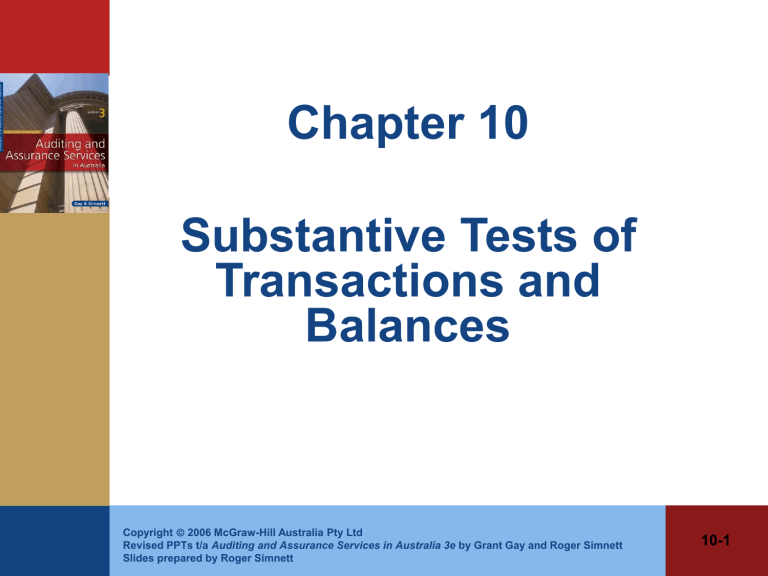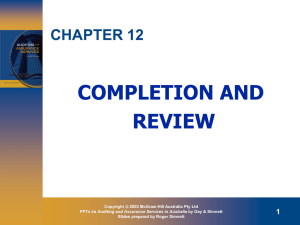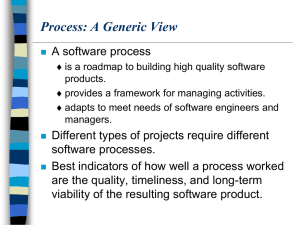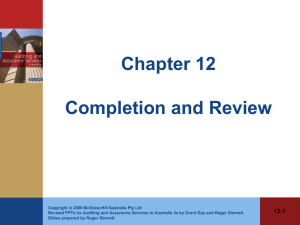Chapter 10

Chapter 10
Substantive Tests of
Transactions and
Balances
Copyright
2006 McGraw-Hill Australia Pty Ltd
Revised PPTs t/a Auditing and Assurance Services in Australia 3e by Grant Gay and Roger Simnett
Slides prepared by Roger Simnett
10-1
•
•
•
•
Learning Objective 1:
Relationship Between Evidence Gathering
Procedures
Auditor has to obtain sufficient appropriate evidence to support the audit opinion.
Tests of controls (chapter 9) and substantive tests of transactions and balances are the main evidencegathering procedures.
Auditor selects most efficient and effective combination of audit procedures that allows them to achieve audit objective.
Assertions are used to help them in their risk assessment of material misstatement, and to direct their audit procedures to the assessment of these risks.
Copyright
2006 McGraw-Hill Australia Pty Ltd
Revised PPTs t/a Auditing and Assurance Services in Australia 3e by Grant Gay and Roger Simnett
Slides prepared by Roger Simnett
10-2
Relationship Between Tests of Controls and Substantive Tests of Transactions
•
•
• Most controls are built around transaction flows.
Tests of controls: transactions selected to test whether related controls are working. Does not directly measure monetary error in accounting records.
Substantive test of transactions: transactions selected to determine whether monetary errors have occurred.
Copyright
2006 McGraw-Hill Australia Pty Ltd
Revised PPTs t/a Auditing and Assurance Services in Australia 3e by Grant Gay and Roger Simnett
Slides prepared by Roger Simnett
10-3
Dual Purpose Tests
•
•
•
These are tests of transactions that address both control and substantive matters simultaneously.
Very common in practice since both tests of controls and substantive tests of transactions involve inspection of documents.
It is efficient to perform tests of control and substantive tests on transactions selected simultaneously, e.g. select document and check evidence of authorisation
(test of control) and recompute amount (substantive test of transaction).
Copyright
2006 McGraw-Hill Australia Pty Ltd
Revised PPTs t/a Auditing and Assurance Services in Australia 3e by Grant Gay and Roger Simnett
Slides prepared by Roger Simnett
10-4
•
•
•
Relationship Between Substantive Tests of
Transactions and Balances
Objective of substantive tests is to reduce detection risk.
Substantive tests of transactions focus on the individual transactions that make up the balance.
Substantive tests of balances substantiate the ending balance of an account (which is comprised of multiple transactions).
Copyright
2006 McGraw-Hill Australia Pty Ltd
Revised PPTs t/a Auditing and Assurance Services in Australia 3e by Grant Gay and Roger Simnett
Slides prepared by Roger Simnett
10-5
Distinguishing Between Substantive Tests of
Transactions and Substantive Tests of Balances
•
Extract from Accounts Receivable Subsidiary Ledger
Customer
Able
Baker
Chan
Year-end Balance
5000
500
1000
Transactions for Able
Sales 2000
Receipts (1000)
Sales 4000
The $5000 balance for Able could be verified by confirming this balance with customer (test of balances) or verifying to supporting documentation the three transactions comprising this balance (tests of transactions).
Copyright
2006 McGraw-Hill Australia Pty Ltd
Revised PPTs t/a Auditing and Assurance Services in Australia 3e by Grant Gay and Roger Simnett
Slides prepared by Roger Simnett
10-6
•
•
Learning Objective 2:
Financial Report Assertions and
Substantive Audit Procedures
The auditor develops specific audit procedures to evaluate and address the risk of material misstatement for both classes of transactions and events, and account balances.
The risk associated with each assertion is assessed, and substantive audit procedures are directed at specific assertions based on this assessment.
Copyright
2006 McGraw-Hill Australia Pty Ltd
Revised PPTs t/a Auditing and Assurance Services in Australia 3e by Grant Gay and Roger Simnett
Slides prepared by Roger Simnett
10-7
•
•
•
•
•
Assertions about Transactions and Events
(Income Statement Accounts)
Occurrence: in testing whether transactions that generated financial report accounts actually occurred.
Completeness: the auditor identifies evidence indicating items that should be included in the class of transactions and investigates whether they are, in fact, included.
Accuracy: relates to determining the appropriate recording of the dollar value and other information of transactions.
Cutoff: involves checking that transactions are recorded in the correct period.
Classification: in designing substantive tests for the assertion of classification, the auditor considers the appropriate classification of the item in the financial report.
Copyright
2006 McGraw-Hill Australia Pty Ltd
Revised PPTs t/a Auditing and Assurance Services in Australia 3e by Grant Gay and Roger Simnett
Slides prepared by Roger Simnett
10-8
•
•
•
•
Assertions about Account Balances at
Period End (Balance Sheet Accounts)
Existence: the auditor selects from items contained in the accounting records and obtains evidence that supports them.
Rights and obligations: the auditor must ascertain that the assets are owned/controlled by the client and that the liabilities are those of the client.
Completeness: the auditor identifies evidence indicating items that should be included in the account balance and investigates whether they are in fact included.
Valuation and allocation: the auditor considers the appropriateness of the basis of valuation of the asset or liability and the basis of any allocation of this valuation across accounting periods.
Copyright
2006 McGraw-Hill Australia Pty Ltd
Revised PPTs t/a Auditing and Assurance Services in Australia 3e by Grant Gay and Roger Simnett
Slides prepared by Roger Simnett
10-9
Existence/Occurrence and Completeness
Assertions
Note that the direction of testing determines whether existence/occurrence or completeness assertion is tested.
Source
Documents existence (of account balance components)/ occurrence (of transactions in accounting records)
Accounting
Records
Completeness (of accounts balance components or transactions in accounting records)
Copyright
2006 McGraw-Hill Australia Pty Ltd
Revised PPTs t/a Auditing and Assurance Services in Australia 3e by Grant Gay and Roger Simnett
Slides prepared by Roger Simnett
10-10
Learning Objective 3:
Cash, Cash Receipts and Cash Payments:
Assertions of Interest
These are primarily:
Cash
• Existence;
• Completeness; and possibly
• Valuation and allocation (if foreign currency balances).
Cash receipts/payments
•
•
•
Occurrence
Completeness; and possibly
Accuracy (if foreign currency transactions).
since these are areas where misstatements are most likely to occur.
Copyright
2006 McGraw-Hill Australia Pty Ltd
Revised PPTs t/a Auditing and Assurance Services in Australia 3e by Grant Gay and Roger Simnett
Slides prepared by Roger Simnett
10-11
Approach in Auditing Cash Balances
•
•
Determined by assessing level of control risk in bank and cash handling procedures.
Much of this information will come from evaluations and tests of controls in the sales and cash receipts system, and the purchases and cash payments system.
Copyright
2006 McGraw-Hill Australia Pty Ltd
Revised PPTs t/a Auditing and Assurance Services in Australia 3e by Grant Gay and Roger Simnett
Slides prepared by Roger Simnett
10-12
Assertions, Objectives and Procedures for
Cash Receipts and Payments
Copyright
2006 McGraw-Hill Australia Pty Ltd
Revised PPTs t/a Auditing and Assurance Services in Australia 3e by Grant Gay and Roger Simnett
Slides prepared by Roger Simnett
10-13
Assertions, Objectives and
Procedures for Cash
Table 10.1 Assertions about account balances (cash)
Copyright
2006 McGraw-Hill Australia Pty Ltd
Revised PPTs t/a Auditing and Assurance Services in Australia 3e by Grant Gay and Roger Simnett
Slides prepared by Roger Simnett
10-14
Cash – Key Procedures
• These are:
–
–
O btaining confirmation of bank balances from client’s bankers.
T esting of client’s bank reconciliation.
Copyright
2006 McGraw-Hill Australia Pty Ltd
Revised PPTs t/a Auditing and Assurance Services in Australia 3e by Grant Gay and Roger Simnett
Slides prepared by Roger Simnett
10-15
Learning Objective 4:
Sales, Cash Receipts and Accounts Receivable
Sales/cash receipts
• Occurrence
• Accuracy
Accounts receivable
• Existence
• Valuation and allocation
-
Assertions of interest as these are areas in which misstatements are most likely to occur
Copyright
2006 McGraw-Hill Australia Pty Ltd
Revised PPTs t/a Auditing and Assurance Services in Australia 3e by Grant Gay and Roger Simnett
Slides prepared by Roger Simnett
10-16
Accounts Receivable:
Key Audit Procedures
•
•
•
•
•
• Confirmation
Subsequent receipts review
Cutoff
Analytical procedures
Tests of sales transactions
Review of aged trial balance
Copyright
2006 McGraw-Hill Australia Pty Ltd
Revised PPTs t/a Auditing and Assurance Services in Australia 3e by Grant Gay and Roger Simnett
Slides prepared by Roger Simnett
10-17
Assertions, Objectives and Procedures for Sales
Copyright
2006 McGraw-Hill Australia Pty Ltd
Revised PPTs t/a Auditing and Assurance Services in Australia 3e by Grant Gay and Roger Simnett
Slides prepared by Roger Simnett
10-18
Assetions, Objectives and Procedures for
Accounts Receivable
Table 10.2 Assertions, objectives and substantive procedures for accounts receivable (p. 465)
Copyright
2006 McGraw-Hill Australia Pty Ltd
Revised PPTs t/a Auditing and Assurance Services in Australia 3e by Grant Gay and Roger Simnett
Slides prepared by Roger Simnett
10-19
Accounts Receivable
Confirmation and other Procedures
• Auditor may obtain confirmation from debtors using:
–
–
Positive form – once debtor has been selected, auditor must obtain evidence and asks client to respond, whether or not they agree with information as to amount owed in request.
Negative form – requests client to respond when they disagree with amount shown.
– Auditor should also consider other procedures such as examining evidence of subsequent cash receipts, and examining sales and shipping documents.
Copyright
2006 McGraw-Hill Australia Pty Ltd
Revised PPTs t/a Auditing and Assurance Services in Australia 3e by Grant Gay and Roger Simnett
Slides prepared by Roger Simnett
10-20
Format of Positive Accounts Receivable
Confirmation Requests
Copyright
2006 McGraw-Hill Australia Pty Ltd
Revised PPTs t/a Auditing and Assurance Services in Australia 3e by Grant Gay and Roger Simnett
Slides prepared by Roger Simnett
10-21
Confirmation Procedure Versus
Subsequent Cash Receipts Testing
Subsequent cash receipts testing is commonly viewed as a superior form of evidence to confirmation procedures because it achieves both key assertions.
•
•
Confirmation
Existence
Valuation and allocation
YES
NO
Subsequent cash receipts testing
• Existence YES
• Valuation and allocation
YES
Confirmation still requires tests of likelihood of payment (doubtful debts provision), which is part of valuation and allocation.
Copyright
2006 McGraw-Hill Australia Pty Ltd
Revised PPTs t/a Auditing and Assurance Services in Australia 3e by Grant Gay and Roger Simnett
Slides prepared by Roger Simnett
10-22
Learning Objective 5:
Purchases and Inventory
•
•
Inventory consists of goods to be sold or used in the production of saleable goods.
Major transactions involving inventory: increase to inventory when goods purchased and decrease to inventory when goods sold.
Copyright
2006 McGraw-Hill Australia Pty Ltd
Revised PPTs t/a Auditing and Assurance Services in Australia 3e by Grant Gay and Roger Simnett
Slides prepared by Roger Simnett
10-23
Risk Assessment of Inventory
• Inventory is generally considered high risk because:
–
–
–
– it is significant to determination of income; it involves a high volume of activity; it involves accounting complexities; it is susceptible to manipulation.
Copyright
2006 McGraw-Hill Australia Pty Ltd
Revised PPTs t/a Auditing and Assurance Services in Australia 3e by Grant Gay and Roger Simnett
Slides prepared by Roger Simnett
10-24
Inventory: Assertions of Interest
• Two key assertions of inventory are generally:
–
– existence valuation and allocation.
Copyright
2006 McGraw-Hill Australia Pty Ltd
Revised PPTs t/a Auditing and Assurance Services in Australia 3e by Grant Gay and Roger Simnett
Slides prepared by Roger Simnett
10-25
Inventory: Key Procedures
•
•
•
•
Observation of physical inventories;
Analytical procedures;
Cutoff;
Tests of pricing and summarisation.
Copyright
2006 McGraw-Hill Australia Pty Ltd
Revised PPTs t/a Auditing and Assurance Services in Australia 3e by Grant Gay and Roger Simnett
Slides prepared by Roger Simnett
10-26
Assertions, Objectives and Procedures for
Purchases
Copyright
2006 McGraw-Hill Australia Pty Ltd
Revised PPTs t/a Auditing and Assurance Services in Australia 3e by Grant Gay and Roger Simnett
Slides prepared by Roger Simnett
10-27
Assertions, Objectives and Procedures for
Inventory
Table 10.3 Assertions, objectives and substantive procedures for inventory (p. 473)
Copyright
2006 McGraw-Hill Australia Pty Ltd
Revised PPTs t/a Auditing and Assurance Services in Australia 3e by Grant Gay and Roger Simnett
Slides prepared by Roger Simnett
10-28
Inventory — Observation of Physical
Inventory: Stocktake
•
•
•
Where inventory is considered material, auditor should attend a physical inventory count (stocktake), unless impractical.
When attending stocktake, auditor uses a combination of observation, inquiry and making test counts.
If inventory is outside auditor’s area of expertise, he/she should consider utilising services of expert.
Copyright
2006 McGraw-Hill Australia Pty Ltd
Revised PPTs t/a Auditing and Assurance Services in Australia 3e by Grant Gay and Roger Simnett
Slides prepared by Roger Simnett
10-29
Inventory: Tests of Pricing and
Summarisation of Count Procedures
• A combination of vouching, tracing and recomputation.
In performing these procedures auditor’s main concerns are:
–
–
–
– identifying obsolete, excess and slow-moving items; that inventory is counted correctly and that the results of inventory count are updated correctly; that prices for goods are applied appropriately; that inventory is appropriately valued at the lower of the cost and net realisable value;
Copyright
2006 McGraw-Hill Australia Pty Ltd
Revised PPTs t/a Auditing and Assurance Services in Australia 3e by Grant Gay and Roger Simnett
Slides prepared by Roger Simnett
10-30
Learning Objective 6:
Accounts Payable and Payments
•
•
•
A primary assertion of concern is completeness, as the most likely form of misstatement is understatement.
Confirmation is a common audit procedure that addresses this assertion.
A search for unrecorded liabilities and analytical procedures performed on related expense account balances are also common procedures for completeness.
Copyright
2006 McGraw-Hill Australia Pty Ltd
Revised PPTs t/a Auditing and Assurance Services in Australia 3e by Grant Gay and Roger Simnett
Slides prepared by Roger Simnett
10-31
Assertions, Objectives and Procedures for
Purchases
Copyright
2006 McGraw-Hill Australia Pty Ltd
Revised PPTs t/a Auditing and Assurance Services in Australia 3e by Grant Gay and Roger Simnett
Slides prepared by Roger Simnett
10-32
Assertions, Objectives and Procedures for
Accounts Payable
Copyright
2006 McGraw-Hill Australia Pty Ltd
Revised PPTs t/a Auditing and Assurance Services in Australia 3e by Grant Gay and Roger Simnett
Slides prepared by Roger Simnett
10-33
Learning Objective 7:
Non-Current Assets
•
•
The balances of non-current asset accounts are usually affected by a few relatively large transactions each year.
For this reason, it is usually efficient for auditors to verify account balances by performing tests on individual transactions.
Copyright
2006 McGraw-Hill Australia Pty Ltd
Revised PPTs t/a Auditing and Assurance Services in Australia 3e by Grant Gay and Roger Simnett
Slides prepared by Roger Simnett
10-34
Property, Plant and Equipment
• Assertions of interest are generally:
–
–
– existence rights and obligations valuation and allocation.
Copyright
2006 McGraw-Hill Australia Pty Ltd
Revised PPTs t/a Auditing and Assurance Services in Australia 3e by Grant Gay and Roger Simnett
Slides prepared by Roger Simnett
10-35
Property, Plant and Equipment:
Key Procedures
•
•
• Substantiating additions and identifying retirements;
Considering any revaluations;
Analytically testing and recomputing related expense accounts such as depreciation.
Copyright
2006 McGraw-Hill Australia Pty Ltd
Revised PPTs t/a Auditing and Assurance Services in Australia 3e by Grant Gay and Roger Simnett
Slides prepared by Roger Simnett
10-36
Assertions, Objectives and Procedures for
Property, Plant and Equipment
Copyright
2006 McGraw-Hill Australia Pty Ltd
Revised PPTs t/a Auditing and Assurance Services in Australia 3e by Grant Gay and Roger Simnett
Slides prepared by Roger Simnett
10-37
Investments and Intangible Assets
• Assertions generally of interest are:
–
–
–
Rights and obligations
Existence
Valuation and allocation.
Copyright
2006 McGraw-Hill Australia Pty Ltd
Revised PPTs t/a Auditing and Assurance Services in Australia 3e by Grant Gay and Roger Simnett
Slides prepared by Roger Simnett
10-38
Assertions, Objectives and Procedures for
Investments
Copyright
2006 McGraw-Hill Australia Pty Ltd
Revised PPTs t/a Auditing and Assurance Services in Australia 3e by Grant Gay and Roger Simnett
Slides prepared by Roger Simnett
10-39
Intangibles – Use of Experts
•
•
Assertions in relation to existence, valuation and allocation for intangible assets are particularly subjective given the nature of intangible assets.
Auditor may consider the use of experts where issues are outside of auditor’s own expertise.
Copyright
2006 McGraw-Hill Australia Pty Ltd
Revised PPTs t/a Auditing and Assurance Services in Australia 3e by Grant Gay and Roger Simnett
Slides prepared by Roger Simnett
10-40
Investments and Intangibles:
Key Procedures
•
•
•
•
•
Physical examination
Confirmation
Inspection of legal documents
Recomputation, vouching, tracing
Specialised valuation procedures.
Copyright
2006 McGraw-Hill Australia Pty Ltd
Revised PPTs t/a Auditing and Assurance Services in Australia 3e by Grant Gay and Roger Simnett
Slides prepared by Roger Simnett
10-41
Learning Objective 8:
NonCurrent Liabilities and Owners’
Equity: Key Procedures
•
•
Key assertion:
– completeness
Key procedures:
–
–
–
– confirmations reading minutes of meetings examination of contracts and agreements inspection of share registers.
Copyright
2006 McGraw-Hill Australia Pty Ltd
Revised PPTs t/a Auditing and Assurance Services in Australia 3e by Grant Gay and Roger Simnett
Slides prepared by Roger Simnett
10-42
Assertions, Objectives and Procedures:
Non-Current Liabilities
Copyright
2006 McGraw-Hill Australia Pty Ltd
Revised PPTs t/a Auditing and Assurance Services in Australia 3e by Grant Gay and Roger Simnett
Slides prepared by Roger Simnett
10-43
•
•
•
•
Learning Objective 9:
Income Statement Accounts:
Assertions of Interest
In a double-entry accounting system, testing one side of a transactions automatically tests the other side.
A procedure that achieves an audit objective for one side of a transaction should achieve a comparable audit objective for the other side.
For example, if the auditor verifies the existence of an accounts receivable balance, this will verify the occurrence of the related sales transactions.
For this reason the extent of substantive tests of transactions is negatively related to the amount of substantive testing of balances that is undertaken.
Copyright
2006 McGraw-Hill Australia Pty Ltd
Revised PPTs t/a Auditing and Assurance Services in Australia 3e by Grant Gay and Roger Simnett
Slides prepared by Roger Simnett
10-44
Audit Procedures for Income Statement
Accounts
•
•
•
•
Substantiation indirectly by simultaneous tests of accounts, e.g. sales
accounts receivable;
Substantiation directly in conjunction with balance sheet accounts, e.g. plant & equipment
depreciation
Substantiation directly by analytical procedures, e.g. relationships following a predictable pattern such as sales
sales commission
Substantiation directly by separate tests of individually significant transactions, events or account balances, e.g. discontinued operations
Copyright
2006 McGraw-Hill Australia Pty Ltd
Revised PPTs t/a Auditing and Assurance Services in Australia 3e by Grant Gay and Roger Simnett
Slides prepared by Roger Simnett
10-45
•
•
Learning Objective 10:
Auditing by computer:
Testing clients’ files
The major way the auditor uses the computer for substantive tests involves using audit software to read clients ’ master files and/or transactions files.
Major advantages:
– D irects auditor’s attention to items of risk and/or materiality;
– Undertakes routine audit tasks efficiently.
Copyright
2006 McGraw-Hill Australia Pty Ltd
Revised PPTs t/a Auditing and Assurance Services in Australia 3e by Grant Gay and Roger Simnett
Slides prepared by Roger Simnett
10-46
Functions of Audit Software
•
–
–
–
–
This software can interrogate clients ’ files in order to:
–
– select sample items; identify records meeting specified criteria (exception reporting); test and make calculations; compare data in separate fields or on separate files; summarise data; write reports.
Copyright
2006 McGraw-Hill Australia Pty Ltd
Revised PPTs t/a Auditing and Assurance Services in Australia 3e by Grant Gay and Roger Simnett
Slides prepared by Roger Simnett
10-47
•
•
•
•
Auditing by Computer:
Four Major Techniques
Generalised audit software – audit interrogation software used with many clients;
Specialised audit software – audit interrogation software especially written for client, task or industry;
Utility programs – software or hardware designed to accomplish common routine tasks, e.g. sort, merge;
Systems management programs
– enhanced productivity tools (e.g. data retrieval software) typically part of sophisticated operating systems environments.
Copyright
2006 McGraw-Hill Australia Pty Ltd
Revised PPTs t/a Auditing and Assurance Services in Australia 3e by Grant Gay and Roger Simnett
Slides prepared by Roger Simnett
10-48





